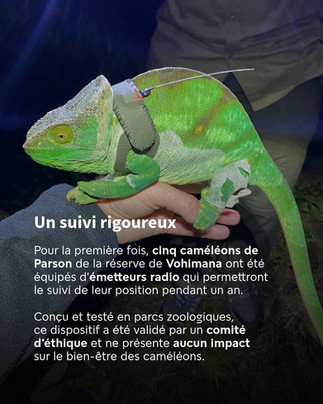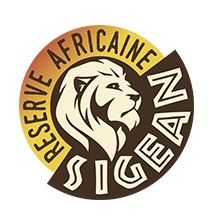An unprecedented scientific mission for the world's largest chameleon gets under way in Vohimana
- Sebastien Metrailler

- Jul 2
- 3 min read
Updated: Jul 30

Caméléon Center Conservation (CCC) is proud to announce the launch of a ground-breaking and ambitious scientific mission in the Vohimana reserve in Madagascar. For an entire year, an international, multidisciplinary team will be closely monitoring the world's largest chameleon: Parson's Chameleon (Calumma parsonii).
Why is this mission so important?
Because this is the first time that such long-term monitoring has been put in place for this species: 12 months of radio-tracking with detailed and systematic data collection. The aim is clear: to gain a better understanding of the precise ecological and biological requirements of this emblematic species so that it can be effectively protected in its natural habitat.
Calumma parsonii is now classified as 'Near Threatened' by the IUCN, and is facing deforestation, habitat fragmentation and a rapid decline in its populations. Yet it remains surprisingly little known: its biology, seasonal behaviour and precise habitat requirements have never been studied in depth in the field.
An innovative and rigorous scientific approach
At the heart of the project is the radio-tracking of ten adult chameleons, divided into two phases: the first five have already been fitted with miniature VHF transmitters, and five more will be fitted in a few months' time.
The transmitters are the result of a year of painstaking development work at Chester Zoo, where captive Parson's chameleons were fitted out and monitored over the long term to refine and validate the attachment technique. The result is a harness system designed to avoid any friction and approved by the zoo's ethical and scientific committees. It guarantees no stress, no injury and no change in behaviour, even over long periods.
In the field, each chameleon is carefully captured, examined, fitted out and released immediately in the exact spot where it was captured, in order to respect its natural habits as much as possible. For a year, precise data will be collected every week: GPS position, microclimatic conditions (temperature, humidity, UV), habitat characteristics and observed behaviour.
The aim of this rigorous scientific approach is to provide unprecedented, robust data to help us better understand the species' ecological needs and put in place practical, appropriate conservation measures.
International and local collaboration to promote conservation
This exemplary project is based on a genuine alliance between local and international expertise:
Local guides from the Vohimana Reserve and Madagascan students, trained and responsible for weekly monitoring of chameleons throughout the project; the first student to begin this monitoring for two months is Liantsoa Nourally Goullam Houssen;
Dr. Angelinah René De Roland (University of Toliara), supervising data collection in the field;
Dr. Olivier Marquis (Parc zoologique de Paris - Muséum national d'Histoire naturelle de Paris and scientific supervisor for CCC) and Dr. Benjamin Drouet (veterinary supervisor for CCC);
Jay Redbond (Chester Zoo, United Kingdom);
And our local partner, the NGO L'Homme et l'Environnement, which manages the Vohimana reserve and ensures that the project is firmly rooted in the field.
By bringing together the skills of zoologists, field scientists and local communities committed to protecting their environment, this mission demonstrates the strength of a collaborative and participatory approach.
Unprecedented results for concrete protection measures
For 12 months, the teams will be collecting detailed data on the chameleons' movements, the size of their home range, their preferred microhabitats and the influence of the seasons on their behaviour.
This unprecedented data will make it possible to:
Identify priority areas for conservation;
Adapt forest management actions to the real needs of the species;
Publish solid scientific results that will serve as a reference for future in situ and ex situ conservation projects for the Parson's chameleon.
In addition to research, the project also includes local awareness-raising initiatives. The aim is clear: to strengthen the understanding and support of local populations for the sustainable and shared protection of Madagascar's biodiversity.
Thanks to our partners
This ambitious project has been made possible thanks to the financial and technical support of the Parc zoologique de Paris (Muséum national d'Histoire naturelle), the NGO L'Homme et l'Environnement, the Fondation Le Pal Nature, Chester Zoo, Muzoo La Chaux-de-Fonds, the Réserve Africaine de Sigean and AFSA (Francophone Association of Animal Caretakers).
A huge thank you to all our partners and donors for their commitment to our cause!














































Comments